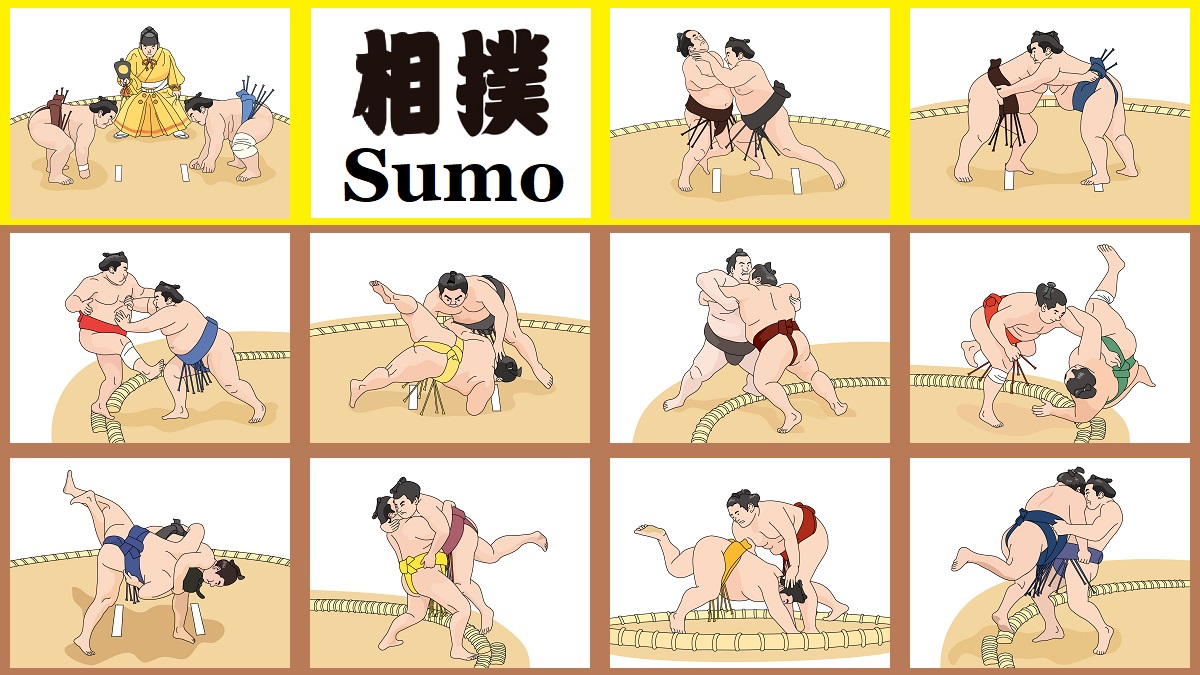Sumo - Japanese traditional wrestling
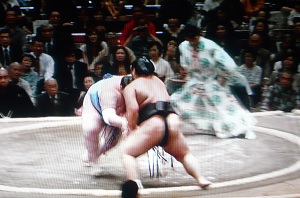
Fighting sumo wrestlers and the gyoji
Simple and unique rules of sumo
The rules of sumo are very simple.
And sumo has a few unique rules including the action as Shrine ritual.
- Only two wrestlers have a match on a circular sumo ring 4.55 meters across.
- The wrestler fights naked except for a loincloth called "Mawashi" with bare hands.
(Under the the fore part of Mawashi, a decoration with some straps called "Sagari" are set up.) - Both wrestlers must bow to each other, before and after the match.
- Both wrestlers sprinkle salt to purify the ring, before they take the starting position.
- Both wrestlers must start at the same moment.
Therefore, both wrestlers need to find a timing to start each other with landing on own both fists and glancing into opponent's eyes.
The referee (He is called "Gyoji") never call the start.
But if one starts earlier even a little than the other, the referee orders them to restart. - To win,
(1) He puts the opponent out of the ring, or
(2) He makes a part of the opponent's body except bottom of foot touch the ground. -
Therefore, a match mostly takes only within 10 seconds.
If it takes over a minute, it's a very long match. - To win, the wrestler pushes and pulls the opponent's body and breaks down the opponent's posture using the arm, foot and body.
And by gripping the opponent's Mawashi, he can lift or throw the body.
But kicking, striking with the fist, gripping the hair, or pulling the ear, etc. are forbidden. - There is no weight class.
So big wrestler use the power and weight, but small wrestler need technique and speed.
Oozumo (Grand sumo tournament)
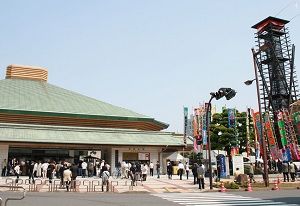
Ryogoku Kokugikan arena
Oozumo is the sumo matches by professional sumo wrestlers, and it is managed by the Japan Sumo Association.
It has a long history since the 17th century.
It is named "Grand Sumo Tournament" in English, and it is held 6 times a year.
- January, May, September : Ryogoku Kokugikan in Tokyo
- March : Osaka city
- July : Nagoya city
- November : Fukuoka city
Especially, Ryogoku Kokugikan in Tokyo is the home arena and it has the head office and the museum of Sumo.
Every tournament is held during 15 days.
The first day is on Sunday and the last day is on Sunday two weeks later.
(In many cases, the first day is the second Sunday of the month.)
All professional sumo wrestlers belong to the Japan Sumo Association.
There are about 600 wrestlers, and all of them participate in every tournament.
Recently the number of foreign wrestlers has been increasing.
Ranking in Oozumo
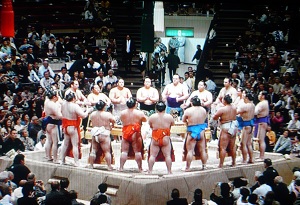
Ring-entering ceremony by Makuuchi wrestlers
All sumo wrestlers are ranked.
There are 6 divisions of rank.
Basically the wrestlers ranked in the same division fight together and they compete for the championship of each division.
The divisions are as follows, in the order of descending rank.
The numbers are the capacity in the rank.
- Makuuchi (幕内) : 42
- Juryo (十両) : 28
- Makushita (幕下) : 120
- Sandanme (三段目) : 180
- Jonidan (序二段) : about 200
- Jonokuchi (序の口) : about 40
"Makuuchi" is the top division with strong star wrestlers.
"Jonokuchi" is the division of beginners, and most wrestlers start from this division.
Each wrestler is ranked with the number in each division.
The wrestlers enter the sumo ring from east side and west side.
So, two wrestlers have the same rank number, but the higher rank wrestler is given "east" and the other wrestler is given "west".
(For example, Juryo east 1st > Juryo west 1st > Juryo east 2nd > Juryo west 2nd > ...)
The highest "Makuuchi" and "Juryo" are the divisions as professional wrestler.
The wrestlers in the lower divisions are regarded as apprentice.
So, the wrestlers in "Makuuchi" and "Juryo" get a high salary and are given good treatment.
As above, there are only 70 wrestlers in Makuuchi and Juryo.
They are only about 11% of all wrestlers.
The wrestlers in the lower division make an effort to be promoted to such high divisions.
"Makuuchi" has only the 42 strongest wrestlers, but some special and honorable statuses are set up in the division.
The statuses are as follows, in the order of descending status.
- Yokozuna (横綱) : a few
- Oozeki (大関) : a few
- Sekiwake (関脇) : basically 2
- Komusubi (小結) : basically 2
- Maegashira (前頭) : remaining (about 30-34)
"Maegashira" is the main part of "Makuuchi", and the wrestlers have the ranking number as well as the lower division.
There are "Komusubi", "Sekiwake" and "Ozeki" as the high statuses over maegashira.
Only several strong wrestlers are given these statuses.
"Yokozuna" is the highest and special status, so it is the top of all wrestlers.
It is translated as "Grand Champion" in English.
Only the wrestler who can win the tournament every time is allowed to be given the status.
Yokozuna must appear in the last match of the day and show the match with strong power and technique.
And Yokozuna must perform the traditional entrance ceremony on the ring before the matches of Makuuchi.
Body of Sumo wrestler
Of course, bigger and heavier Sumo wrestler is more advantageous.
So, they must increase the weight and develop the muscles.
Now, the average weight of wrestlers in Makuuchi is more than 160 kilograms.
The heaviest weight is over 200 kilograms, and even the weight of lightest wrestler is around 100 kilograms in Makuuchi.
In the low divisions, some wrestlers weighs around 70 kilograms equal to ordinal man.
Sumo wrestlers seem very fat men, but the body fat percentage is about the same as common men.
So, the quantity of muscles of them is very large.
When a wrestler rams the body against the opponent at the start of the match, it is said that the impact is the same as the power of collision with two-ton truck.
So it is necessary that the muscles and bones are extraordinarily strong and tough.
In addition, the swiftness and the flexibility are needed.
By the way, no sumo wrestler is tattooed on the body.
There is social feeling that Japanese people hate tattoo.
Sumo is a Shinto ritual, so tattooed body in front of God must be avoided.
Tattooed man can not be a Sumo wrestler.
Sumo ring name
Each wrestler of Oozumo has a ring name.
In Japanese, it is called "Shikona".
The name is registered in the ranking list.
His master gives a good name to him, or he names himself his favorite name.
Some wrestlers use own real family name directly when they are beginners, but most of them also change to some ring name.
Most names consist of four Japanese characters or less.
Even foreign wrestler is given such name of Japanese characters.
Of course, the naming is free.
But, the name to make audiences feel strong or to give audiences an impact is good.
The characters meaning "mountain", "sea", "ocean", Mt.Fuji", etc. are often used.
They give the grand and massive impression.
And the characters meaning "dragon", "giant bird", "fly", etc. are also often used.
They give the strong and active impression.
The name is used like his family name while he is the wrestler of Oozumo.
Sumo audiences know him by the intelligible ring name and cheer him.
The schedule of Oozumo
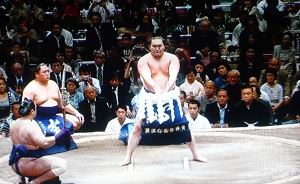
Yokozuna Dohyo-iri ceremony
Each wrestler fights only one match a day in the tournament, so he needs high concentration.
The wrestler below Makushita has 7 matches during 15 days.
So he fights once in 2 or 3 days.
The wrestler of Juryo and Makuuchi has 15 matches.
So he fights every day.
They fight against different oppositions in the tournament.
Therefore, Oozumo is similar to league competition.
Yokozuna and Oozeki are the star players.
Mostly, they remain as the tournament favorites in the last part of the tournament.
So, the matches of Yokozuna and Oozeki each other are planned as big matches around the time as big matches.
The schedule of a day is the following.
Some matches by young wreslers out of division start at around 8:00.
They are the debut matches of the new wrestlers.
Then, the matches of "Jonokuchi" start at 8:30.
Many matches are done in the order of ascending rank.
(Current total number of the matches in a day is 150 to 160.)
Before the matches of Juryo and Makuuchi, there are Ring-entering Ceremonies ("Dohyo-iri" in Japanese).
They are the ceremony that the wrestlers are introduced.
After Dohyo-iri of Makuuchu, only Yokozuna performs special Dohyo-iri.
Then the matches of Juryo start around 14:30 and the matches of Makuuchi start around 16:00.
The last match of the day by Yokozuna ends just before 18:00.
Determining the winner
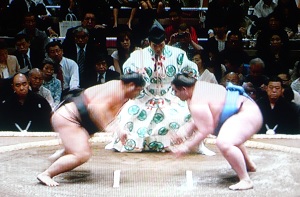
Start of a match
On a sumo ring, there is a referee who wears a traditional costume.
He is called "Gyoji".
He conducts a match, and determines the winner of match.
The wrestlers are not allowed to make a claim against the judgement.
But there are 5 judges out of sumo ring.
If one of them has objection against the judgement by Gyoji, the gyoji and the judges discuss on the ring immediately, and they make a final decision.
(Of course, video images are also used for the judgement.)
After the judgement, the wrestlers bow to each other and Gyoji announces the name of the winner.
Decision of the Champion
The champion is the wrestler who has had most wins in the division.
In most cases, the wrestler below Makushita wins all matches (7 matches).
The wrestler of Juryo wins over 11 matches in 15 matches.
If some wreslers are the same wins, playoff matches are held on the last day.
Usually the champion of Makuuchi has 12 to 15 wins in 15 matches.
Because Yokozuna is the strongest wrestler, he commonly get the champion in many tournaments and that is the duty of Yokozuna.
But, Oozeki aiming to become new Yokozuna, new up-and-coming wrestler, etc. sometimes appear and they win the tournament.
The appearance of new hero creates an exciting tournamnent.
Promotion and demotion
After the tournament, the wrestler who has gotten many wins is promoted to higher rank.
(Over 8 wins in 15 matches in Makuuchi and Juryo, Over 4 wins in 7 matches in the lower divisions)
By contraries, the wrestler who has gotten a little wins is demoted to lower rank.
If a wrestler on the high level of a division has gotten many wins, he is often promoted to higher division.
He will fight on the new rank in the next tournament.
But, it is very difficult to be promoted to the highest statuses "Oozeki" and "Yokozuna".
A wrestler of "Sekiwake" must continue to get marked wins for a few tournaments (about over 33 wins for 3 tournaments).
And, when the Association recommends him for promotion to "Oozeki", he can get the status.
Additionally, to get "Yokozuna", "Oozeki" wrestler must get distinguished wins during a few tournamens.
As a result, the Association recommends him for promotion.
If Oozeki wrestler can't keep the strength, he is demoted to Sekiwake.
But Yokozuna is never demoted to Oozeki.
Yokozuna is a man who had become "the god of Sumo".
When Yokozuna can't keep the strength, it means that he returns the status of Yokozuna and must retire the Sumo wrestler.
Of course, the matter is left entirely to his judgment.
The rank of Yokozuna has heavy responsibility.
In legend, an extremely strong wrestler appeared in the 17th century and he became the first "Yokozuna".
But, it is recorded that a wrestler became the 4th Yokozuna in 1789.
In over 400-year history of Sumo, only 75 wreslers have gotton the Yokozuna status.
Traditional performances in Oozumo
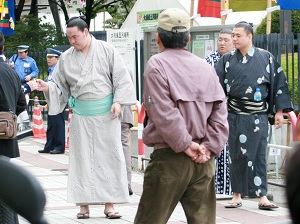
Young sumo wrestlers responding to the fan
- All wrestler wear "Chonmage" of Japanese men's haircut in the Middle Ages.
The wrestlers of Makuuchi and Juryo wear the high-class style of Chonmage named "Ooichou". - Before a match, each wrestler throws salt to purify the sumo ring.
- After the last match of the day, a wresler performs a ceremony whirling a bow.
It honors the winner of the last match, then a day of tournament is closed.
Watching Oozumo
In Tokyo, Oozumo is held at Ryogoku Kokugikan arena located in east side of the central Tokyo.
The Kokugikan is an arena for sumo, and it was constructed by the Japan Sumo Association.
Sometimes, it is used as an arena for other fighting sports.
See the website of the Japan Sumo Association, about the halls in other cities.
In the center of square arena, there is a sumo ring.
Basically wide area surrounding the ring is the reserved seats without chair, so the spectors must sit Japanese style.
This seat is separeted individually, and 4 spectors can sit in there.
The ticket is sold in unit of the seat, so it is expensive.
Behind these area, there are common chair seats.
This seat is cheap, but the spector must see the ring from a distance.
First match in a day starts at around 8:00 in the morning.
And the last match finished around 6 in the evening.
You can watch as long as you like with one ticket.
But most spectors come when the match of Makuuchi starts.
By the way, you can watch Oozumo on television.
During Oozumo is held, NHK (Public broadcast of Japan) broadcasts it live nationally.
The program is broadcast from around 15:00 to 18:00.
Therefore, you can watch the matches of Juryo and Makuuchi.
Of course, Yokozunas appear in the last few matches after around 17:30.
If you are in a hotel or ryokan in the time zone, try to turn on the TV.

